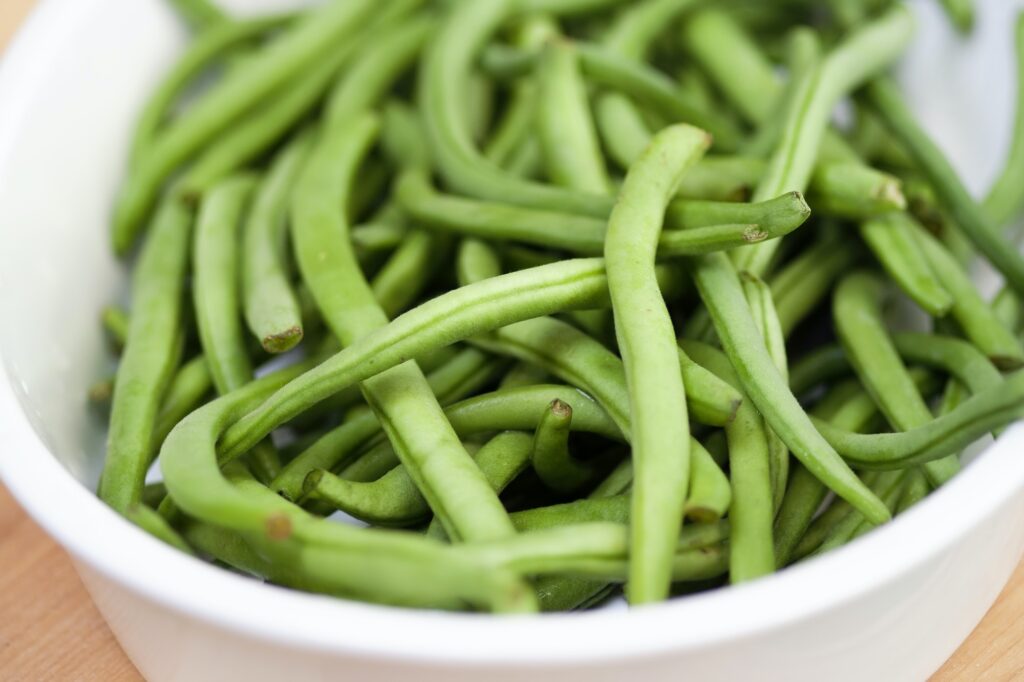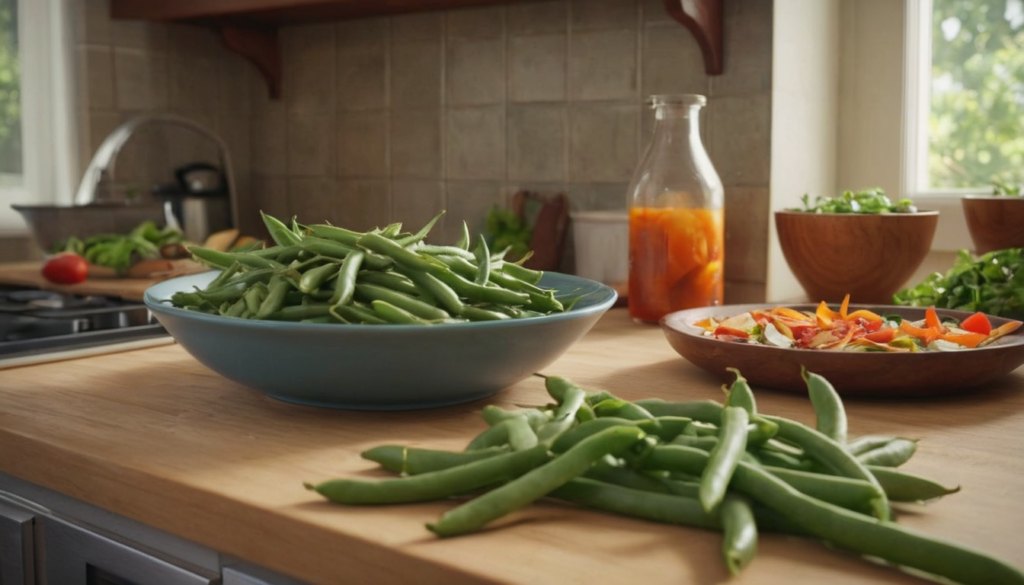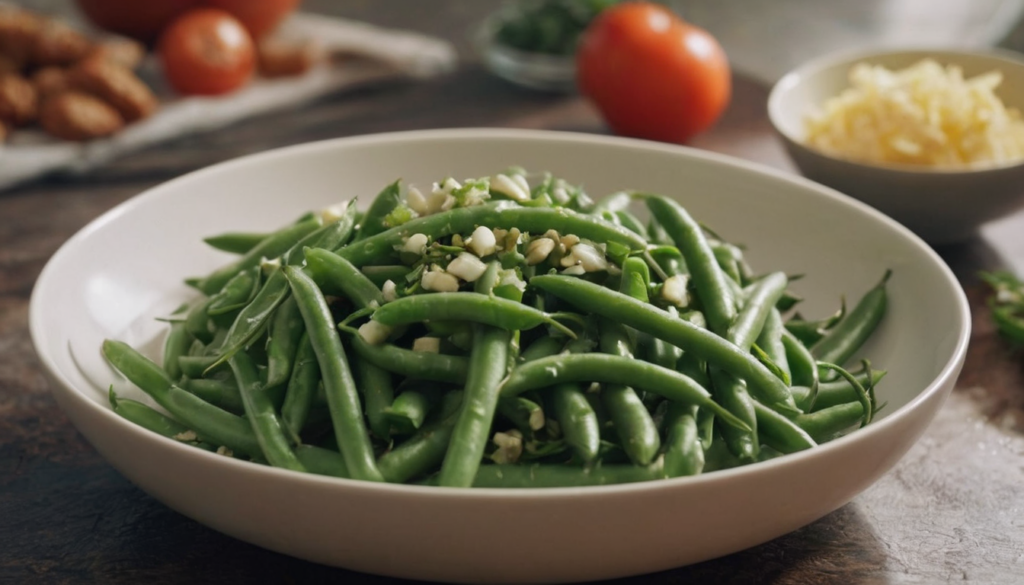11 Interesting Facts About Green Beans

Green beans are one of those vegetables that show up on a lot of dinner tables. Their snappy texture and fresh flavor seem to go with just about any meal. But did you know that beyond being tasty, green beans are also packed with vitamins, minerals, fiber, and disease-fighting compounds?
There’s more to this everyday veggie than meets the eye. Read on to discover 11 fascinating facts about green beans that reveal their health benefits and lesser-known attributes. You’ll gain a whole new appreciation for their nutritional value and background story that spans over 7,000 years!
An Introduction to the Humble Yet Mighty Green Bean
So what exactly are green beans?
Green beans (scientifically known as Phaseolus vulgaris) are the unripe, young seed pods of various cultivars of the common bean plant. They earned the moniker “green” beans for their verdant green color, although they now come in purple, red, yellow, and various speckled shades.
| Nutrient | Amount Per 1 Cup (125g) | % Daily Value* |
|---|---|---|
| Calories | 31 | |
| Total Fat | 0.2 g | 0% |
| Saturated Fat | 0 g | 0% |
| Trans Fat | 0 g | |
| Cholesterol | 0 mg | 0% |
| Sodium | 6 mg | 0% |
| Total Carbohydrate | 7 g | 2% |
| Dietary Fiber | 2.7 g | 10% |
| Total Sugars | 3.3 g | |
| Protein | 1.8 g | 4% |
| Vitamin A | 35 mcg | 4% |
| Vitamin C | 12.2 mg | 14% |
| Calcium | 37 mg | 3% |
| Iron | 1 mg | 6% |
| Potassium | 211 mg | 4% |
*Percent Daily Values are based on a 2000-calorie diet.
Green beans are low in calories and fat but contain good amounts of fiber, vitamins A, C, K, folate, and minerals like iron, calcium, and potassium. They provide antioxidants like flavonoids and carotenoids that can help reduce inflammation, lower cholesterol, and may help prevent some cancers. Overall, green beans are a nutritious vegetable that can be a healthy addition to a balanced diet.
But wait, there’s more…here are 11 interesting facts that reveal the health benefits, history, and attributes of green beans that you probably never knew!
Fascinating Facts About Green Beans

Fact 1: Green beans originated in Peru over 7,000 years ago
The earliest evidence of green beans comes from archeological discoveries in Peru, tracing their origins to over 7,000 years ago. Ancient Peruvians first cultivated and domesticated green beans as one of the early food crops in the Americas.
Their cultivation quickly spread north and south to Central America, Mexico, and beyond. Long before European contact, indigenous peoples were enjoying this nutritious legume. Today, the highest diversity of cultivated bean plants is still found in Latin America.
Fact 2: They Come in Many Different Varieties and Colors
While typically green, common beans can come in almost any color thanks to the selective breeding of heirloom cultivars over thousands of years. Some of the most common varieties include:
- Snap beans – crisp, snappy texture even when raw
- String/French beans – fibrous “strings” formerly removed
- Wax beans – yellow color, delicate flavor
- Italian flat beans – wide and flat-podded
- Asian winged beans – unique winged shape
- Purple/red beans – rich color from anthocyanins
- Speckled beans – spotted color pattern
This spectrum of sizes, shapes, textures, and colors reflects the diversity of the Phaseolus genus. Different pigments also indicate various health-protective compounds like anthocyanins in purple beans.
Fact 3: Green Beans are Rich in Antioxidants
Many nutrients in green beans act as antioxidants – compounds that counter oxidative stress from free radicals in your body. Damaged cells are linked to age-related diseases and inflammation.
Notable antioxidants found in green beans include:
- Carotenoids like beta-carotene, lutein and zeaxanthin – These compounds mop up damaging reactive oxygen species. Carotenoids support eye and skin health.
- Polyphenols and flavonoids – These compounds have anti-inflammatory, anti-tumor and cardioprotective activity according to research.
- Vitamins C and E – These familiar antioxidants boost immune function and benefit skin and eye health.
Loading up on antioxidants from whole foods like green beans helps prevent cellular damage as you age. This protects against cancer, heart disease, vision loss and cognitive decline.
Fact 4: Green Beans Help Moderate Blood Sugar

Eating green beans provides a boost of fiber and protein – both nutrients that moderate the release of sugar into the bloodstream after a meal.
This effect helps prevent unhealthy blood sugar spikes that can lead to weight gain or exacerbate diabetes. Therefore enjoying green beans frequently makes good sense, especially for those managing diabetes or pre-diabetes.
Fact 5: They Promote Heart Health in Various Ways
Thanks to their lineup of protective nutrients, green beans support a healthy heart and circulatory system. For example:
- The fiber scrapes excess cholesterol from artery walls to lower LDL “bad” cholesterol.
- B vitamins regulate homocysteine levels – high levels damage arteries.
- Potassium, magnesium, and calcium relax blood vessels to reduce strain on the heart.
- Vitamin K prevents calcification of soft tissues to keep arteries flexible.
Green beans also provide iron to prevent anemia, folate to lower stroke risk, and antioxidants to combat inflammation – all protective mechanisms for your cardiovascular system.
Fact 6: Green Beans Have Benefits for Digestive Health

With nearly 4 grams of fiber per cup, green beans make an excellent addition to any gut-healthy diet. The indigestible fiber moves through the gastrointestinal tract intact, with beneficial effects including:
- Relieving constipation
- Supporting regular bowel movements
- Promoting the growth of healthy gut flora probiotics
- Preventing diverticulosis by keeping the colon clean
- Reducing risk for gastrointestinal cancers like colon cancer
These benefits also aid in healthy weight maintenance since proper digestion and elimination help the body function more efficiently.
Fact 7: They Help Strengthen Bones
When you think of bone health, calcium and vitamin D usually come to mind first. But other nutrients like magnesium and vitamins K and C also play important roles. Fortunately, green beans provide many of these key micronutrients.
Specifically, the vitamin K in green beans activates osteocalcin, a protein involved in anchoring calcium molecules inside the bone. Research shows getting enough vitamin K improves bone mineral density to lower fracture risk. Between their mineral and vitamin content, green beans support strong bones.
Fact 8: Green Beans May Have Anti-Cancer Effects

So far the cancer-fighting potential of green beans has only been studied in animal and cell models, not human trials. However certain compounds show promise for reducing the risk of some cancer types.
For example:
- Chlorophyll: test tube studies demonstrate anti-tumor effects of chlorophyll against different cancer cell lines. Chlorophyll is the green pigment in all leafy green veggies.
- Carotenoids: lutein and zeaxanthin accumulate in eye and skin tissue, possibly shielding from UV damage that causes melanoma.
- Flavonoids: test tube studies show tumor-inhibiting activity and apoptosis (cancer cell death).
While more evidence is needed, incorporating green beans as part of a high-antioxidant diet makes sense for lowering cancer risk.
Fact 9: They Support Eye Health
Rich in antioxidant carotenoids, green beans help fight free radical damage in the eyes that leads to cataracts and age-related macular degeneration (AMD), the leading cause of blindness.
The two most well-studied eye health carotenoids are lutein and zeaxanthin – both found in green beans. These carotenoids accumulate in high levels in the retina and macula, protecting and preserving your eyesight.
Aim for getting 10 mg daily of lutein + zeaxanthin, an amount found in about 2 cups of cooked green beans. Your future eyes will thank you!
Fact 10: Green Beans Help Reduce Inflammation
Chronic inflammation is involved in nearly all diseases, including arthritis, cardiovascular disease, diabetes, and neurological decline. The antioxidants in green beans combat inflammation for whole body benefits.
Certain anti-inflammatory compounds in green beans include:
- Alpha-linolenic acid (ALA): an omega-3 fatty acid that inhibits pro-inflammatory messaging molecules.
- Quercetin: a flavonoid antioxidant that combats histamine release and inflammatory enzyme activity according to studies.
- Beta-sitosterol: a plant sterol with anti-inflammatory effects in the body.
Making green beans part of an anti-inflammatory lifestyle is smart for lowering disease risk and preventing joint pain.
Fact 11: Fun Fact – There Are Over 130 Varieties of Green Beans!
Thanks to thousands of years of selective breeding by indigenous groups, followed by recent hybridization, there are over 130 documented varieties of common beans (Phaseolus vulgaris).
Beyond all the diverse shapes, sizes, and colors, different varieties contain unique health-promoting compounds. For example, studies show certain heirloom varieties have higher flavonoid content with enhanced antioxidant capacity.
This spectrum of cultivars makes green beans an interesting veggie to experiment with. Try new varieties to discover your favorites!

Conclusion: Green Beans Deserve More Appreciation for Their History, Diversity and Nutrition
Hopefully, these interesting facts gave you a newfound appreciation for the humble green bean. Beyond being a versatile cal veggie, green beans are packed with vitamins, minerals, fiber, and disease-fighting nutrients. Since ancient times, bean plants have sustained cultures across the Americas.
Modern green bean cultivars come in a rainbow of colors with unique phytonutrient profiles suited for optimal health. Their rich background and diversity combined with nutritional benefits make beans far more fascinating than their plain appearance lets on.
The next time you enjoy some green beans, remember just how wholesome, nutritious, and downright dynamic they truly are!
Green Bean FAQs

Do you have questions about selecting, storing, and cooking green beans? Here are answers to some frequently asked questions:
Q: How do I pick the freshest green beans?
A: Look for crisp, bright green pods without brown spots. Beans should snap cleanly when bent rather than appearing limp. Smaller beans tend to be more tender while larger beans can have more seeds.
Q: Is there a difference between green beans and string beans?
A: String beans have a fibrous seam that runs the length of the pod which formerly needed removal. Today’s cultivars lack strings but the name stuck around. Green beans and string beans can be used interchangeably.
Q: How should I store green beans?
A: For short-term storage, refrigerate raw beans in a breathable bag for up to one week. For longer freezer storage, blanch briefly then freeze beans in an airtight container for 6-12 months.
Q: Are green beans better raw or cooked?
A: Both! Raw green beans make great salad, slaw, and dippers. Cooking makes them softer and brings out the sweet flavor. Try a combo in dishes like veggie sautés and casseroles.
Q: Can you eat green bean stalks/plants?
A: Bean leaves, vines, and pods are all edible! However, remove any tough, woody stems. The most tender parts are the young shoot tips and beans themselves. Bean flowers and leaves work in salads.
Q: What’s the healthiest way to cook green beans?
A: To preserve the most nutrients, steam green beans lightly. Other healthy cooking methods include sautéing, roasting or stir frying without too much added fat or overcooking beans until they’re mushy.





